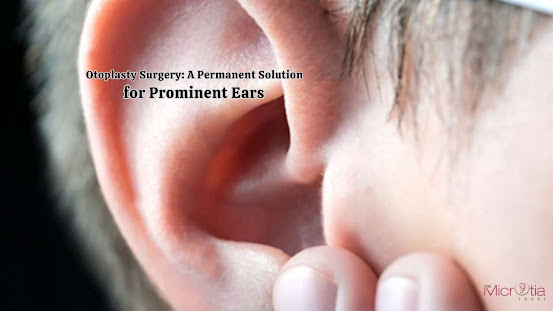Microtia: Causes, Types, Risks And Procedure
A rare condition called microtia affects 1 to 5 of every 10,000 children born worldwide. Congenital ear abnormalities and even the removal of the auricle, the visible component of the external ear, can fall under this category. When an infant is born with microtia, there is a little protrusion or nub where normally would be a completely developed ear.
The objective of otoplasty, commonly referred to as cosmetic ear surgery, alters the size, placement, or contour of the ears. Only after ears have developed to their full size, typically after age 5, otoplasty can be performed at any age into maturity.
The Microtia Trust, the best ear reshaping surgery clinic in Mumbai, offers a variety of ear deformity treatments to patients with microtia, including external and internal ear deformities, prominent ears, and ear loss following injury or burns.
Causes of Microtia-
Even though the exact causes of microtia are unknown, genetic and environmental factors are thought to be the main contributors to this ear impairment. Only 5% of patients are estimated to have genetic characteristics as a contributing factor. The causes of Microtia during fetal development have been addressed by a variety of theories including disruption of neural crest cells, altitude and vascular disruption, however none of them have been verified.
Why is the Surgery done?
A child with Microtia frequently experiences harassment and bullying, especially at school. Many children frequently experience diminished hearing because of a constricted or absent ear canal.
When a person can only listen with one ear, the brain frequently struggles to block out background noise and is unable to identify the origin and direction of the sounds.
Communication impairment in microtia patients generally results from diminished hearing in social and educational contexts.
Note: To maximize symmetry, otoplasty is often performed on both ears. Other reasons include the ears protrude excessively from the head, ears are too large for one’s skull or one is unhappy with a prior ear operation.
Types of Microtia-
Grade 1: Tiny ears and an ear canal that is frequently narrow or occasionally absent.
Grade 2: The upper portion of the outer ear, which is often abnormally formed, frequently has a narrowed or occasionally absent ear canal.
Grade 3: One of most frequent ear conditions, characterized by small, abnormally formed ears without an ear canal.
Grade 4: The condition with the absent ear and ear canal. Anotia is another name for it.
Risks involved in the Surgery-
Scarring: Even while scars are permanent, one won't see them because they'll be concealed behind or in the wrinkles of the ears.
Asymmetry: his might occurs as a result of alterations made all through the process of healing. Additionally, existing asymmetry may not be successfully treated by surgery.
Changes in skin sensation: The ears may need to be repositioned during otoplasty, which may temporarily impair localized skin sensation. The changes are rarely irreversible.
Allergic reaction: An allergic response to the medical tape or other substances used before, throughout, or after the treatment is possible.
Problematic stitches: It may be necessary to remove stitches that were used to stabilize the ear's new shape after they had reached the skin's surface.
Overcorrection: The abnormal shapes produced by otoplasty can give the appearance that ears are pinched back.
Preparation Before The Surgery-
Reviewing the medical history: A discussion of any previous or present medical issues, particularly any ear infections. In addition, the doctor might inquire regarding any medications one is taking or have recently taken, as well as any recent procedures one had.
Physical exam: The doctor will look at the ears, paying attention to their placement, size, shape, and symmetry, in order to decide on the treatment options. The ears may be photographed by the doctor.
Discussing expectations: The doctor will probably ask one why they want an otoplasty and what outcomes they hope to achieve. Make sure one is aware of the dangers of otoplasty, including the potential for overcorrection.
Surgical Procedure-
Microtia Treatment With Cartilage Surgery: The cartilage-like soft tissue of the rib is the perfect material for creating a new ear. The cartilage for the redesigned outer ear is taken from the child's own rib cartilage. After that, a skin graft is applied over the implant to create a solid, realistic-looking ear.
Two stages are involved in microtia surgery-
The rib cartilage is taken in the initial stage. Cultivated cartilage is used to build a three-dimensional scaffold for the ear. The replacement ear is made from cartilage using the patient's second, healthy ear as a template. The full ear framework is then built and placed in the proper location on the side of the head.
From the side, the ear appears entire, but the lobe is absent. Between three and six months following the first stage, the second stage is when the lobe behind the ear is formed. For 5-7 days, a tight bandage keeps the skin graft in place.
Benefits of Otoplasty-
Using the patient's own rib cartilage to build a new ear structure eliminates the possibility of graft rejection.
Results that are natural-looking on one or even both corners of the head.
Hearing issues can also be resolved surgically.
Improves the balance and look of the face.
Aids in people gaining self-assurance and respect.
If someone wishes to have a personal session to discuss their specific concerns. They can visit The Microtia Trust, the renowned ear reconstruction surgery clinic in Mumbai for the cost of otoplasty surgery, and get a consultation from Dr. Parag Telang to get a clearer picture.



Comments
Post a Comment